You have no items in your cart. Want to get some nice things?
Go shopping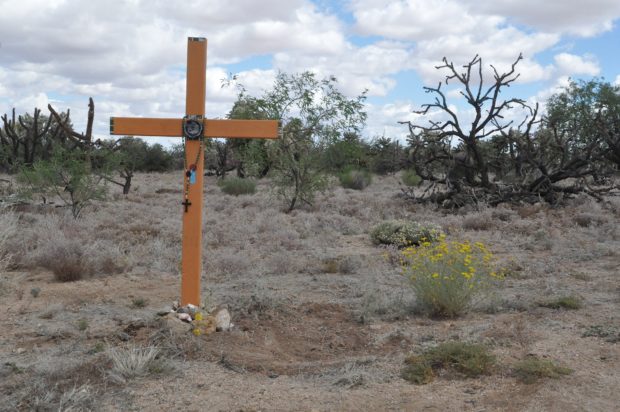
In the early hours of a Tuesday morning, an old man drives a Jeep out of Tucson and onto Highway 286 toward the Arizona desert and the first of three sites he’ll visit where the remains of migrants were found. He has made this trip once a week for the past six years. Three crosses four feet tall and two feet wide, each one a different color, blue, blue-green and rust, rattle in back. Heat from the sun warms the windshield and a woman in the passenger seat, Alicia Baucom, cracks her window to shrieks of air still cool from the night. A second Jeep carries a man and two women who, like Alicia, have volunteered to help plant the crosses. Flat land covered with cactus and scrub juniper slanted by wind unfurls into distant, bare mountains peaked against domes of blue sky slowly revealing itself two hours after dawn, and as the Jeeps rush down the highway, also known as Sasabe Road, the old man, 73-year-old artist Alvaro Enciso, asks Alicia the names of the dead migrants.
—The one found in 2006 is unidentified, she says. The man discovered in 2015 has a name, Valentine Guzman Flores. Thirty. Found December 29 near Three Points. Skeletal remains. Death unknown. The third was found in 2017. His name is Felipe Vargas. Also thirty. Found near Sasabe on June 8. Hyperthermia. Dead less than a day. Coroner said he was fully fleshed.
—The first two could have died long before they were found, Alvaro says.
He hunches over the steering wheel and makes no further comment and Alicia doesn’t speak either. She has been helping Alvaro just five months, replacing another volunteer who broke down after he and Alvaro found a migrant’s body nearly a year ago. The volunteer sought counseling. It was one thing to hear about people dying in the desert but it was quite another to see a body.
Alvaro collects information on dead migrants from the Pima County coroner’s office. Last year, the medical examiner recorded the remains of 127 dead migrants. Before 2000, the bodies of fewer than five migrants were found each year. However, in 2001, the number soared to 79 and then to 151 the year after that. The number of annual migrant deaths since then has remained well above 100.
As he follows the highway, Alvaro notices workers laying asphalt, shoveling it off the back of a truck, the air stung by its sharp odor as a roller inches toward them, and two border-patrol agents lean against pickups and watch the men work. They are either chasing someone, Alvaro says of the agents, or they’ve given up. They don’t move as he passes them, heads down staring through dark sunglasses at the steaming asphalt.
Alvaro often encounters border-patrol agents. A few times he’s tripped a sensor and they converged from nowhere to check him out. He explained his purpose and showed them his crosses and they were cool. He had no problem with them and doesn’t now. They have a job to do; some are good and some are bad. If they see someone in the middle of nowhere, they get suspicious. Alvaro understands that. He shoots the shit with them, complains about the heat. Many of them aren’t familiar with deserts because they were raised outside of Arizona. They’ve seen earthworms but nothing bigger and worms don’t bite. Rattlesnakes do. They worry about snakes.
Alvaro recalls the spring of 2017 when the border patrol could have been a problem. He and some volunteers found a man in the desert walking south toward Mexico. He was delirious and thought he was headed north to Phoenix. He had no food or water. Alvaro considered his options: he could call the border patrol, give the man something to eat and drink, or leave him to his fate. He could not, however, transport him. If the border patrol stopped him, he could be charged with harboring. But the man needed medical attention. How was he to say I can’t help you, to a desperate man? Sometimes, he reasoned, laws have to be violated. The volunteers had their own car and drove the man to a safe house. Alvaro doesn’t remember his name but he was told later that he ate eleven pancakes, three sausages, three cups of fresh fruit, two glasses of orange juice and five pieces of toast his first night. He had come from Honduras and it took him two weeks to recuperate. When he left, the staff gave him directions to Phoenix but he didn’t make it. The border patrol picked him up.
*
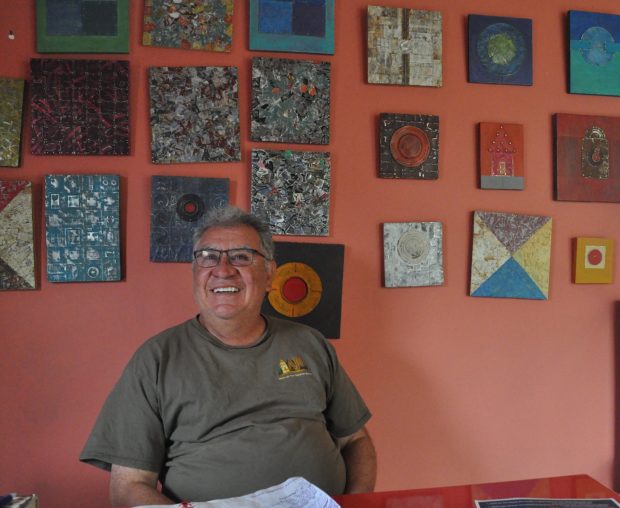
Alvaro had been unaware of migrants dying in the desert when he moved from northern New Mexico to Tucson in 2011. He started walking migrant trails and imagined himself crossing borders on foot. The idea appealed to him as something romantic, people entering the United States seeking the opportunities he had. He noticed all sorts of debris, rusted cans of sardines, sausages, beans and other food migrants had brought with them. He collected the cans and accumulated a huge mound to use for his art. Every can told a story of the person who ate from it. He didn’t know if the story had a happy ending but the can was there for him to imagine a life.
Two years later, he took a four-hour orientation with Tucson Samaritans, a group of more than one hundred volunteers who go into the desert seven days a week to assist migrants. The presenter showed a map of southern Arizona covered with red dots. Each dot represented a spot where a migrant’s body had been found. From 2001 through 2018, the remains of 3,011 migrants have been recovered in southern Arizona. No estimates have been offered for the numbers not found.
Alvaro wondered what happened to those people. He searched those locations for anything that gave substance to those who had died. He lay on his back and stared into an unrevealing desert sky and felt only the emptiness of his surroundings, its nothingness that had absorbed suffering and death.
Alvaro felt a bond with the dead through his own sense of not belonging. He was not a gringo but he didn’t consider himself Hispanic, either. He rarely hung out with Spanish-speaking people, and when he did, he assumed a different character than when he spoke English. Who was he? He had been born in Colombia. He had left everything he knew, his family, his country, to live in a place that was and was not his home. He began contemplating how, as an artist, he could convey the quandary of his existence with the experiences of dead migrants caught between the countries they were leaving and their visions of America.
As a first step, Alvaro snapped photographs of what he called dead sites, but a photo could not capture the absent bodies of migrants. He hired a woman and had her wear a black dress and drove her to the desert to be photographed. He shot beautiful pictures of her against the sparse landscape but a woman in a black dress, a strikingly mournful figure, said nothing about the people who had perished. He made sculptures of red dots but they weighed too much to transport to the dead sites. Next, he sprayed red dots on the ground like graffiti but the dots alone conveyed nothing.
The idea of building crosses came to him as he combed through books about Roman history. The Romans, he read, crucified many people, not only Jesus. They left them exposed to the sun and elements until they died. The same, he believed, was happening to migrants. Through its immigration policies, the U.S. government was forcing them to follow the most difficult routes north to kill them. Where the two pieces of a cross intersected formed the nucleus of an encounter between poor peasants of the south and the American giant of the north and the encounter was fatal. Goliath won.
Alvaro understood that not everyone would agree with his overtly political analogy. However, he was not seeking approval but laying a philosophical foundation to buttress his ideas to mark the dead sites with crosses. Absent politics, a cross would also have meaning, not as Christian symbol (—Forget religion, Alvaro tells the volunteers. Death is very democratic. Death has no interest in faith.), but as a secular, geometric one. A cross consists of vertical and horizontal lines. Alive, people stand erect. Dead, they lie flat. Life and death existed in the same image.
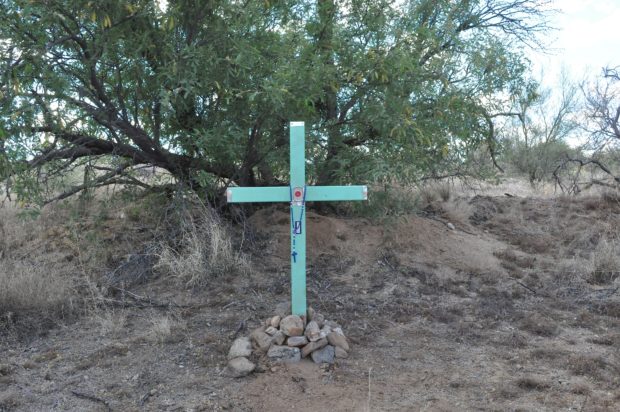
*
As a child, Alvaro had learned to accept absence. He grew up in a shanty in Villavicencio, Colombia, a frontier town where men earned a living raising cattle and selling marijuana. He did not wear shoes his first five years at school. In the evenings, he gathered dead birds from cockfights for his mother to cook, or he would walk to the slaughterhouse and collect blood to eat with his rice because they could not afford meat. His mother had few soft edges. She warned him against daydreaming. Dreams, she said, won’t deliver him from poverty.
Alvaro never saw his father. He was married to another woman and considered Alvaro’s mother his mistress. In 1996, when he turned fifty, Alvaro returned to Colombia and tracked him down in Honda, a village not far from where he grew up. His father owned a big house near a cemetery and had a little store and everybody who went to the cemetery stopped there for food and flowers. He assumed Alvaro wanted money.
I don’t need your money, Alvaro told him. I’m not angry with you. I have no feelings toward you. I just want to know who you are.
They spoke for a short time. His father appeared indifferent that Alvaro, his only son, the result of a one-night fling, had appeared out of nowhere. It was like looking in a mirror, Alvaro reflected afterward. His father’s disinterest, his lack of empathy, were characteristics Alvaro shared. A woman he had dated in New York told him, “You don’t ask about my life or daughters. Your interest lasts only one night.” He received her words as a revelation and on his flight back to the states he thought of them again and decided that it although he felt bad his father was the way he was he did not have to be like him.
They never saw each other again. Blind, sick and unable to walk, Alvaro’s father died two years later.
*
When he was a boy, Alvaro’s watched Hollywood movies at a theater where his mother worked. On screen, actors smoked long cigarettes and ate in restaurants. He saw dashing detectives and strutting cowboys. That was the life he wanted. In 1967, when he was almost twenty-one, an aunt in Queens offered to fly him to New York. She didn’t have to ask twice.
New York made an impression. The tall buildings, the busy streets, the stores with all the elegantly dressed people. He loved the seasons, especially winter. That something could fall from the sky and turn him white left him amazed and a believer in miracles. He thought pizza and canned foods with decorative labels the most wonderful of meals. He sorted through trash, an odd assortment of junk: high-school sports trophies, beat-up bowling balls, picture frames and other garbage. Get this out of my house, his aunt scolded, but he continued adding to his collection. He had never had these things. Ownership represented the promise of America. With his aunt’s help he applied for citizenship and received his green card. He also registered with the selective service without fully understanding what that meant but he felt he was on his way.
However, Alvaro soon faced difficulties. His aunt’s American husband disliked him and kicked him out of the house two months after he arrived. Homeless and fearful of returning to Colombia a failure, he went to a church and prayed. God, he begged, you need to cut me a break. I’m screwed here. Any bone you can send my way, I’d appreciate. You’re the guy who’s supposed to help.
Two months later he was drafted into the Army and sent to Vietnam. Having no skills, he joked, they put me in the infantry. It was not the divine intervention he had sought but it got him off the street. His commanding officers trained him to hate the Vietnamese and kill them and he did. Today, he doesn’t see a connection between the person he was then and the man he is now. He was young, naive and stupid. He lacked compassion. He believes that with each cross he puts up today he atones for his actions in Vietnam.
*
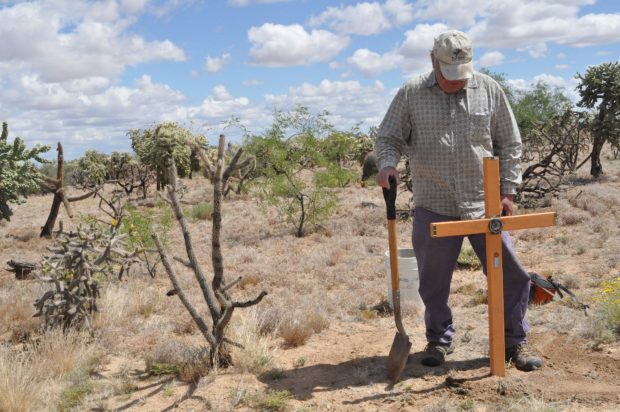
After his service, Alvaro returned to New York. He visited an Army buddy in New Mexico and fell in love with the desert, awed by its immense limitlessness, and promised to return and live there some day. Back in New York, he drove cabs, mopped the floors of a peep show and working as a photographer’s assistant. He attended college and graduate school and earned three master’s degrees in anthropology, Latin American Studies and Contemporary Hispanic Studies. In 1980, he took a job with the Department of Health and Human Services and stayed for almost twenty years before he got tired of the nine-to-five grind and decided to pursue an artistic career. He had always liked to draw. His savings, pension and veterans’ benefits would support him. With art, he rationalized, he didn’t need credentials.
In 1999, he moved to Placitas, New Mexico, an old hippy town north of Albuquerque, and bought a house. For two years he read books on philosophy and art criticism. He built boxes with cutout figures representative of the American West. He took large canvases and painted layers and layers of the same color paint in varying shades and made frames for them. It’s not bad, he thought, but it may not be good art. Over the years, however, people bought his work and he felt their approval in the money they paid him and that in turn gave him the impetus to do more serious work that would encompass his ideas of being an outsider. After more than ten years in Placitas, Alvaro felt the need for a more urban environment. Albuquerque was close by but he wanted a city with a better reputation for the arts. That led him to Tucson.
*
A hawk flies above the Jeep as Alvaro drives deeper into the desert, the sun higher but the air still cool although he feels it warming. Gusts rise off mountains sweeping the air ahead of it, fanning dust. Alvaro pulls off the road and parks near the spot where the remains of the nameless 2006 migrant were found. He had put up a cross for him last year. A migrant sleeping nearby awoke, startled to see him. Don’t worry, Alvaro said, I’m here for a cross, nothing more.
Alvaro doesn’t know what happened, but a short time later someone destroyed the cross. Hunters have used his crosses for target practice. Other people break and remove them. He went to a swap meet one afternoon and saw one for sale. The cross he had placed here looked like it had been hit by a sledgehammer.
Stepping out of the Jeep, Alvaro stands stoop-shouldered and adjusts his cap. He wears jeans that pool around his ankles and a long-sleeve shirt with triangular patterns that restrains his paunch. Gray hair falls to his neck and he removes his glasses and rubs his eyes.
—Keep talk to a minimum, Alvaro says. We’re going to a location where someone died.
He takes a blue cross from the back of the Jeep. Slivers of tin cans decorate the wood. A red dot on another piece of tin fills the center. Friends give him paint, off-white, beige, bland colors he brightens with whatever he has on hand in his shop.
The volunteers unload a shovel, bucket, bottled water and a bag of cement and follow Alvaro. The noise of their steps breaks against small stones and the scraping sound tears at the air like a ripped sheet.
Alvaro moves cautiously between jumping cholla cactus, whose stinging thorns collect like burs and can easily penetrate clothing. Blankets, shoulder packs, worn sandals, plastic water jugs and other supplies discarded by migrants litter the ground. They may have camped here. They may have been picked up by family or border patrol. Their abandoned possessions offer Alvaro no hint of their fate.
He searches the ground for bones. In 2017, a man driving home from a casino stopped to piss and saw a human skull. The skull belonged to forty-four-year-old Nancy Ganoza, from Peru, who had disappeared in the desert in 2009, cause of death unknown. A DNA sample found a match in New Jersey where her two daughters and husband lived. Her family flew to Tucson and Alvaro built a cross and they joined him to raise it where her skull was found. Her husband propped a photograph against the cross below a red dot. She had black hair down to her shoulders and a winsome smile and she squinted as if she was facing the sun. Five candles surrounded the base of the cross and a white rosary with a crucifix hung loosely from it, and a circle of prickly pear cactus threw shadows beneath the twisted branches of velvet mesquite. Alvaro had planted dozens of crosses for people by then. Sometimes he knew their names but he did not know them. Until now. The intimate presence of Nancy’s family brought him to tears.
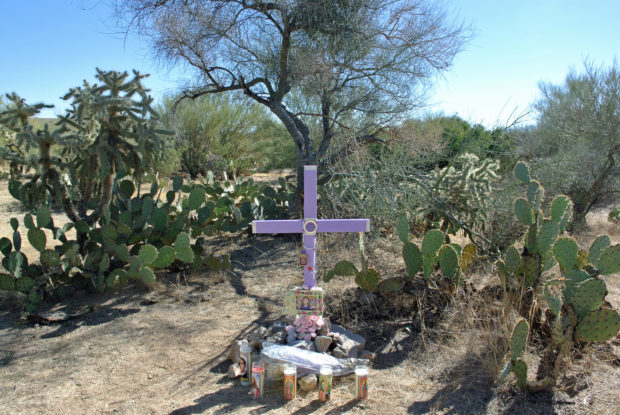
It’s so sad, Alvaro thinks now. All of it. Each death haunting. All of them tragic, some beyond tragic. Not too long ago Alvaro built a cross for a young man who had died from hanging, a suicide, the medical examiner concluded. Alvaro could not conceive the agony and utter hopelessness that he must have experienced. Knowing it was too much to go on. Deciding with what strength he had left to take his own life rather than die of thirst, starvation, heatstroke, hyperthermia, or madness.
The most disturbing moment for Alvaro, however, occurred last August when he found a body in the Roskruge mountain range, a remote area close to Tucson. Five miles from a paved highway, four miles from some houses but still in the middle of nowhere. He had just put up a cross and was following a stone path back to his Jeep when he disturbed two rattlesnakes and his heart was racing from surprise and fear, the sound of their rattles still in his ears, when he saw a dead woman. For a moment, his reaction was similar to entering a room and encountering someone he had not expected.
A sharp odor rose from the corpse. The bones remained intact and her clothes lay around her, possible torn off by animals. A T-shirt and blue jeans and a cell phone. She had a pair of yellow-and-pink sneakers that looked new. Very feminine and small. At first, Alvaro thought she was a child. He called 911. An autopsy revealed she had suffered hyperthermia and had been dead about two weeks. She had documents from Guatemala but no identification.
Days later, Alvaro marked the location with a cross. Was she a mother? he wondered. Did she leave children behind? What was she running from and to? In the following weeks he returned and looked for ID but found nothing. He lay on the ground and traced an outline of his body with flour. He stood and looked at the image like something from a crime scene. It was his way of sharing himself with her. Had his life been different, had his aunt not flown him to New York, he might have died as she had, or like the migrant he is about to acknowledge this morning, dead without a name.
*
Alvaro sets down the cross, takes the shovel and digs a hole. He tosses dirt to one side and when he stops to catch his breath, silence settles around him and he raises his head to listen to it. He asks Alicia to mix the cement. He watches her shake it into the bucket, add water and stir it with a stick.
—That’s enough, Alvaro says.
He inserts the cross into the hole and holds the top of it as Alicia distributes the cement. Alvaro asks her if it’s straight and she nods. He continues holding it as she and the other volunteers collect rocks and stack them in a small mound around the cross. Once it’s secure, Alvaro steps back and ponders it within the vast solitude of the desert. Stalwart, like a sentry, unaware that soon it will be alone and appear quite small, dwarfed by the limitlessness of its surroundings.
Alicia removes a flute from her shoulder pack.
—I’d like to play “Amazing Grace.”
—Play “Down in the Valley.”
—I don’t know that one. I hope I can get through this without crying.
—That’s OK. Someone died here. Crying is what we do.
She begins playing and Alvaro bows his head. He has put up nine hundred crosses in six years but has no idea how many still stand. They last five, maybe ten years, eaten by termites, beaten by weather, turned to dust. Some nuns in a church in Cochise County heard about what he was doing and designed their own crosses. They did not place them where migrants died but, as far as Alvaro was concerned, where it was convenient. Their crosses have no relation to anything. The word got out that an old man was making crosses and the nuns wanted a piece of it.
He does not consider himself an activist. At home, he likes to read, go to restaurants and play with his dog. He paints pictures with red dots in fragmented circles and lines to represent a splintered border and the ruptured lives of those who cross. He only wants the integrity of his project respected.
What’s happening, he tells himself, is that instead of mellowing he’s becoming cantankerous in his old age. How does he tell nuns they’re screwing up? They have a divine license to do what they do. They have God. How does he argue with God?
I’m an infidel, he reminds himself.
As Alicia plays, the plaintive notes drifting with the wind, Alvaro considers his own life. With each cross, he commemorates his journey as an immigrant and its inevitable end. His weekly desert sojourns have become a form of meditation in which he grieves his own losses, two failed marriages, the death of his mother, his time in Vietnam, his absent father. He is his father’s son but not his son. He does not conceal his emotions. He empathizes to the point of tears. He can’t control what other people do with his art but only what he seeks to achieve with it: recognition of the dead, solace for himself.
The struggle of migrants, he knows, will outlive him. More will die today, tomorrow and long after he has died. He’d like to paint three thousand red dots in a Tucson gallery but he doubts that will happen. Galleries don’t appreciate art that won’t sell. He will never build enough crosses.
—That’s all we know, right? It was a male? Alvaro asks Alicia when she finishes playing.
—That’s correct.
—Does anyone want to say anything?
—I hope he finds peace, Alicia says.
Alvaro lets her comment linger. The wind whistles and carries the sound of a semi and the volunteers shift and twigs break beneath their feet. When the noise of the truck fades, Alvaro speaks.
—In 2006, thirteen years ago more or less, a man came here looking for the American dream. He didn’t find it and all of his plans ended here. And those plans and his dream left a lot of suffering behind with a family that perhaps was hoping for him to be the person who would send checks back home for them to survive. But this all ended here. We don’t know his name, but he had a name, a family, and he had dreams and hopes, he had everything. That’s why we do this, to give this person presence. To honor this person. But there will always be an empty space at the dinner table for this person and that takes a long, long time to go away; in fact, it never will. He’ll always be missing in some way.
At a loss to say anything more, Alvaro stares at the ground. He wonders how much longer he’ll mark dead sites. His knees are shot. In the old days, he’d start at seven, walk three hours to a site and three hours back, up and down mountains, sometimes not getting home before nightfall. These days, he seeks clusters, areas where several bodies have been found, so he can put up crosses without walking too far and adding mileage to the Jeep. It’s old, too.
He picks up the bucket and shovel. The two other sites are close by. He expects to finish before noon, an early day. Next Tuesday, he will return and carry more crosses into the desert and give presence to the anonymous dead with a marker no one will see. Art without a viewer. He considers their shortened lives part of the American myth. Dying for a dream.
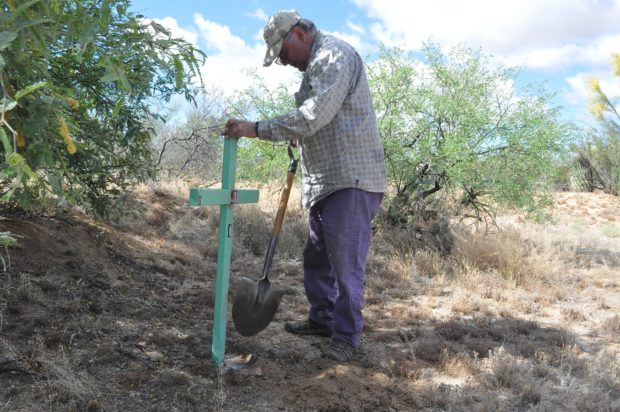
About J. Malcolm Garcia
J. Malcolm Garcia is a recipient of the Studs Terkel Prize for writing about the working classes and the Sigma Delta Chi Award for excellence in journalism.
- More Posts(5)




